3 personalization tweaks that boosted my sales by 70%


Think about the last time you were asked what you did for a living.
Maybe you were asked by a family member. Or a neighbor. Or someone you were sharing drinks with at an industry conference. Or (if you do a lot of international travel), an immigration officer.
If you’re like me, how you describe what you do depends on who is doing the asking.
I do this. You do this. Everyone does this. We personalize what we say depending on who we’re talking to, what kind of relationship we have with them, and how they’re behaving. Because in a way, describing ourselves is selling ourselves.
Kathy Sierra, the author of Badass: Making Users Awesome, says it best: “Find out what they do, need, and want, and map what you offer [that is, what you’re selling] into something meaningfully relevant for that person.”
That’s why sales calls and live demos are so effective — a great salesperson is going to take the time to figure out who their audience is, what they want, and how what they’re selling can help them specifically.
But what about those of us who sell online?
What if we don’t have the ability to talk individually with every prospect?
What if we have a low-touch sales process that’s largely dependent on having people read automated emails and sales pages, and deciding to buy entirely on their own?
In this article, I’ll show you how your business can get many of the same benefits offered by a high-touch, personalized sales experience, but at scale. For my business, we’ve been able to increase sales by 70% and opt-ins by almost 250% just by speaking a little more directly to the individuals visiting my website.
Big businesses like Amazon have been personalizing their website and their marketing for years (to great effect). What I see on the homepage of Amazon.com is much different than what you see, and it’s because Amazon is reacting to the signals I’ve already sent: What I’ve bought, what I’ve browsed, etc. And the signals I send Amazon are different than yours.
The good news is that you can do much of what big guys are able to do — and probably with the tools and services you’re already using.
Here’s the plan:
- To help you break apart the audience and customer base you have now into discrete segments. (Step 1)
- Then, to create a few ways of automatically assigning people into segments based on explicit input or behavior. (Step 2)
- And finally, to get what you’re saying — over email and your website — to speak directly to the individuals in your audience. (Step 3)
Over time, you’ll not only get a better understanding of who your audience is, but you’ll also be able to understand your metrics. What types of people are most likely to subscribe or buy? What types aren’t? And how can you get more high value right away — and, conversely, what can you do to increase conversions for those who aren’t converting well?
Done correctly, you’ll increase your conversions and sales because what you’re saying and selling will be more relevant to people. And the good news is that you don’t need to be a company the size of Amazon to make this happen!
Step 1: Capture raw data and refine into segments

You can’t personalize until you’ve …
- … determined who you’re speaking to. This means understanding who they are and what they want from you by collecting as much raw data and feedback as possible.
- Then, you must use that raw data to find patterns and create a handful of segments.
- Lastly, come up with a list of messaging changes (sales copy, testimonials, etc.) to make when someone belongs (or doesn’t belong) to a particular segment.
First, let’s make sure we’re all speaking the same language.
What’s a segment?
A segment is a group that someone belongs to. An individual who engages with you likely belongs to multiple segments, and each segment is created with the intent that some sort of action takes place when someone belongs to it.
Let’s say that you run an online store that sells supplements. Consider you have two people who are browsing around your-supplement-store.com:
- Mary, a 22-year-old female who wants to compete in her first triathlon within a year or two.
- Bob, a newly single 55-year-old man who wants to lose weight now that he’s dating again for the first time in a while.
The products you’re selling could benefit both Mary and Bob. But these two people are going to have different reasons for wanting your products.
Thinking strategically about your segments, you could come up with the following:
Mary:
- Female (demographic)
- 18-30 years old (demographic)
- Interested in strength training (behavior)
- Wants to compete in an event (intent)
Bob:
- Male (demographic)
- 50+ years old (demographic)
- Interested in strength training (behavior)
- Wants to lose weight (intent)
Demographic (or “firmographic”) segments make a lot of sense when showing testimonials and case studies. Bob is going to want to see other older guys who have lost weight. Mary’s going to want to see young women who have gained muscle.
Behavioral segments help us draw conclusions based on how someone is acting. If someone is browsing articles or even products related to gaining muscle mass, we can make an assumption. Are they reading articles on insomnia? They’re having issues sleeping. Articles on focus? Their productivity sucks.
Intent segments tell us why they’re behaving in a certain way. Why does Mary want to get into strength training? She wants to compete in a triathlon. And Bob? Why does he want to lose weight? He’s dating again.
If you were selling offline, you’d naturally learn these things about your customers. You’d take into account who you’re speaking to and change what you’re saying.
But before you can do this online, at scale and automatically, you need to first come up with your initial set of segments. Let’s look at how to do that.
How can you (automatically) learn more about your audience?
The best way to learn about your customers is to reach out and talk to them (or to use automation to facilitate conversations).
GMB Fitness does this really well. It has created a series of training courses. Like many training businesses, they do best by getting new visitors to first opt in to their list before asking for the sale.
At a recent conference, CEO Andy Fossett shared that by asking new subscribers about who they are and what they were hoping to achieve, GMB has been able to learn about who makes up their audience. They then use that as an opportunity to individually point new subscribers to an appropriate introductory product.
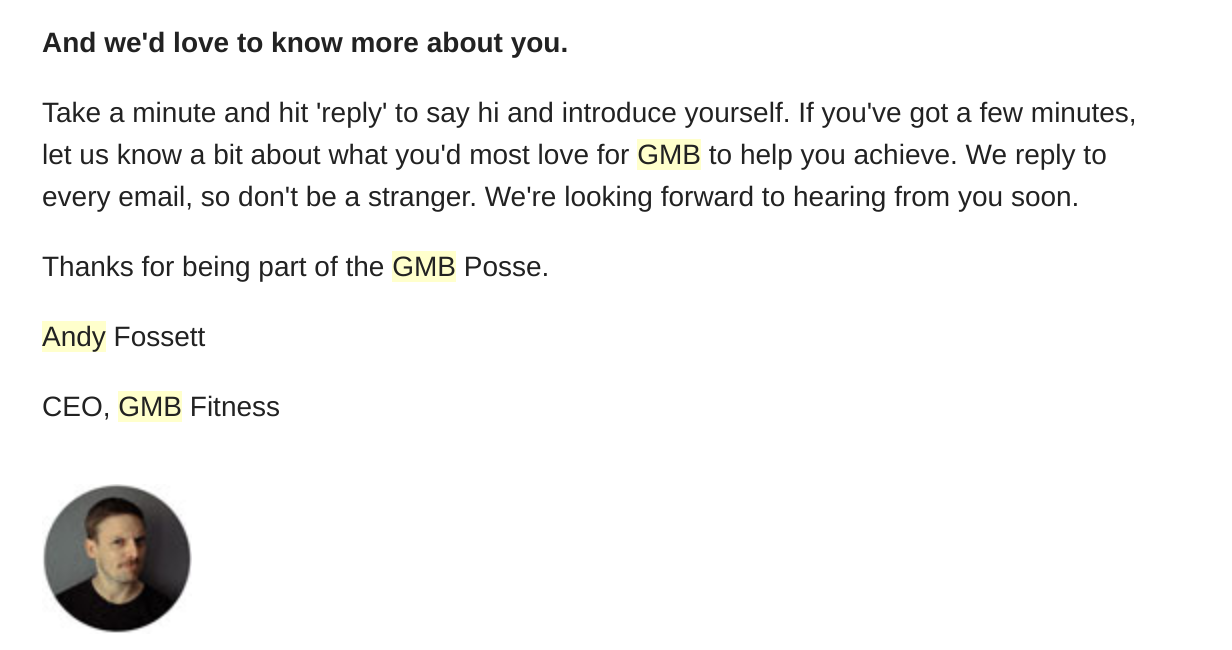
Questions like the above are always great for capturing the kind of raw data that can ultimately be distilled down into segments that describe who someone is, what life is like for them, and what change they’d like to see happen (i.e. why they would purchase your product).
Here are some great ways to collect raw data from your audience:
- A “reply and tell me…” P.S. at the footer of your subscriber onboarding emails.
- Immediately after buying, ask new customers to tell you who they are and what led them to buy.
- A few days or weeks after a sale, ask customers how they are using your product or service.
- Add call-to-actions within email courses or emails that are sent out as lead magnets (“Reply and tell me a bit about what you plan on doing now that you’ve learned X…”).
- Interactive worksheets that you can attach to educational emails or content.
- Intercom-style chat widgets on your site.
- Get on Skype calls with new subscribers or customers, and use rev.com to transcribe the recorded audio.
Turning raw material into segments
Raw, unfiltered data is great. You’re able to read (in their own words!) who your audience is, and what they want.
… But it’s not useful for personalizing at scale.
Humans are pretty good at parsing and using raw data. Give a salesperson a questionnaire that was filled out by a prospect when submitting a lead form, and they’ll probably do a good job at taking that into consideration in how they sell.
Computers, however, aren’t that advanced yet. Since your website and automated emails are powered by computers, we need to convert the raw data we’ve been collecting into ifs and thens.
“If the person viewing is a full-time employee, then change this headline to read…”
This means we need to figure out how to determine the “if.” I’ll describe this more technically in the next section, but basically this is going to be something like “If customer, then…” or “If referred from IWT, then…”
We’ll also need to determine the “then”: “If referred from IWT, then use language specific for online entrepreneurs.”
Often times, the “then” will be copy changes: tweaks to the vocabulary, the examples given, the way the offer is described, and so on. Other times, it’s a structural change: Remove the “Sign up” button if someone’s a customer, show this set of trust logos if they belong to a given industry, and so on.
For now, we’re going to try to make sense of the raw material you’ve been collecting.
Start by scanning for choice sentences or phrases that highlight how someone describes:
- Themselves or their business.
- The problem(s) that led them to you.
- The life they want to live or the business they want to run (basically: what they think they might be able to get from you).
- The self-limiting beliefs or actual objections that are keeping them from bettering themselves or their business.
How do different types of people describe why they’re here and what they want from you?
An easy way to do this is to use a spreadsheet.
My current focus, RightMessage, is a company that helps people easily personalize their websites. (No surprise here, right?)
We created a spreadsheet that helped us identify who was interested in what we were doing and why they joined our early access list. The spreadsheet was simple (you can see it here): Why?, What?, Business Type, ESP (Email Service Provider).
An email was sent to about 1,000 people on our early access list and asked people to select what kind of business they ran, their ESP, and then gave an open-ended text area to enter in what they were hoping to accomplish using personalization.
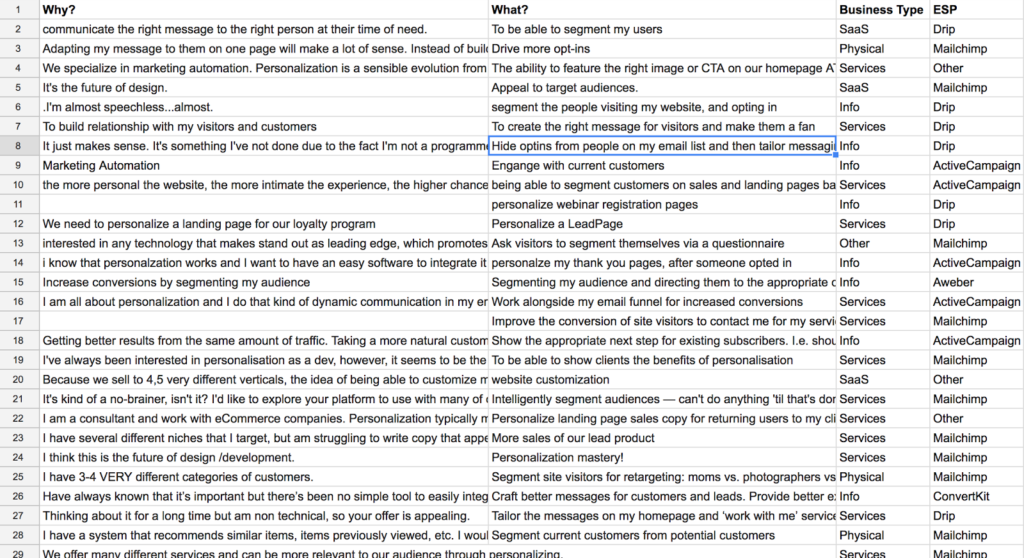
Populating this spreadsheet had us trying to pull out of each submission the Why (why someone was interested in personalization) and What (what somebody wanted to achieve with personalization).
It took a bit of time, but it helped us write the generalized initial sales page copy. Joanna Wiebe of Copy Hackers likes to say that great copywriting is curation rather than creation, and that’s exactly what we did — we recycled open-ended feedback into persuasive copy.
But then we had to come up with what specific changes we’d make based on someone’s business type. Fortunately, through the magic of Google spreadsheet filters, we could quickly isolate just the Whys and Whats for a specific business type.
(To filter in Google Sheets, select a column, choose “Data” -> “Filter,” and then click the funnel icon at the top of the column to filter based on values.)
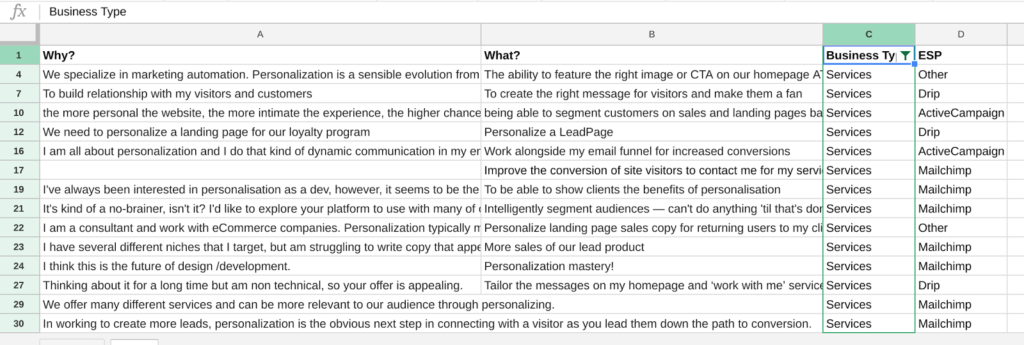
Now we could see how SaaS businesses described what they needed, and we were able to identify a few themes that only SaaS businesses were talking about. This gave us the foundations we needed to help answer, “If business type is SaaS, then say…”
I’ve been doing this for the last few years for my other business, Double Your Freelancing. Depending on what kind of consultant you are, whether you’re solo or work with a team, and more, I’ve changed up the language, examples, testimonials, and more.
- If “Why did you join this free course” equals “to learn how to value price,” then change the sales page headline to “Ready to start pricing your work based on the value you create for your clients?”
- If “Business type” equals “Marketer,” then change every usage of “freelancer” to “freelance marketer” and show testimonials from marketers.
- If “Why do you want to price on value” equals “Increase profit,” then change how we describe the offer (product) to be focused on profitability.
By adding a handful of “If this, then that” changes to a single sales page that we link to at the end of an email course, we’ve been able to permanently increase sales by 70%.

Learn to take control of your finances and spend your money GUILT-FREE with our free Ultimate Guide To Personal Finance below:
Step 2: Come up with ways of automatically segmenting your audience

Once you’ve gone through and isolated out the core segments, you’re going to now want to automatically assign your visitors, subscribers, and customers to the segments you’ve identified. There are a number of ways of doing this, but so we can keep things simple and straightforward, I’m only going to focus on the methods that don’t require you to hire a coder or buy any new software.
First thing’s first: How to store subscriber data
Most of us probably have an email list. And if you’re following email marketing best practices, you’re storing purchase data (usually represented as tags) in your email marketing app of choice.
We’re going to leverage the flexibility that most of these tools provide and keep everything we know about someone mirrored in our email marketing database. This includes where they opted in and what they’ve bought, but also answers to survey questions, on-site behavior, etc.
Your email marketing app should allow you to write tags and custom fields. Tags are binary — they’re either on or they’re off. Custom fields allow you to use the name of the field as the “group” and the value as the segment. For example, the custom field “business_type” could be either “software,” “services,” “training,” or “e-commerce.”
If somebody can (and should) belong to exactly one type of segment, you’re going to want to use a custom field.
I’d encourage you to get familiar with how your email marketing app handles subscriber data, what integrations (native or through a tool like Zapier) they support, and how easy it is to use this data — for example, do they have an API? Can website personalization software use this API to modify your website? Can email campaigns easily use subscriber data to dynamically change email content?
All of the strategies I’ve listed below should be doable with most of the major email marketing apps.
Purchases and opt-ins
You can tell a lot about who someone is based on what they’re doing or buying.
Do you sell a number of products? If so, what can you discover about someone based on what they’re buying? For instance, if a customer purchases a “For my wife” anniversary item, they’re probably married, right? And if they’ve bought a course on starting a freelancing career, do you think they’re trying to scale or simply start their business?
By piping your sales data into your email marketing app, you can not only track what someone’s bought (so you don’t end up promoting to them something they already own), but you can make educated guesses about who someone might be based on what they’re buying.
The same goes for opt-ins like content upgrades. If I’m reading an article on “How to get more trials for your app” and opt in to a lead magnet on that page, I’m probably running a software company.
By taking inventory of what kind of actions people take on your website — opt-ins, lead magnet downloads, or purchases — and associating those actions with segments, you can start storing segment data automatically based on what someone’s doing or buying.
Surveys
Usually when people create surveys they focus on obvious questions about demographics or where they heard about you. But, more interesting to me, are questions you could ask that allow your audience to tell you more about who they are and where they want to go.
And it’s easy enough to set this up:
- Create a (free) survey form using a tool like Google Forms. Alternatively, paid options like Typeform, Gravity Forms, SurveyMonkey, etc. exist.
- Use Zapier to connect your form to your email marketing app. Ensure you have an email field.
- Connect field values in your form with custom fields within your email marketing app. For example, you might have a drop-down for “What was your revenue last year?” that lists options like $0 - $50k, $50k - $100k, etc. You could store the value they choose as a custom field on the subscriber record, like “annual_revenue.”
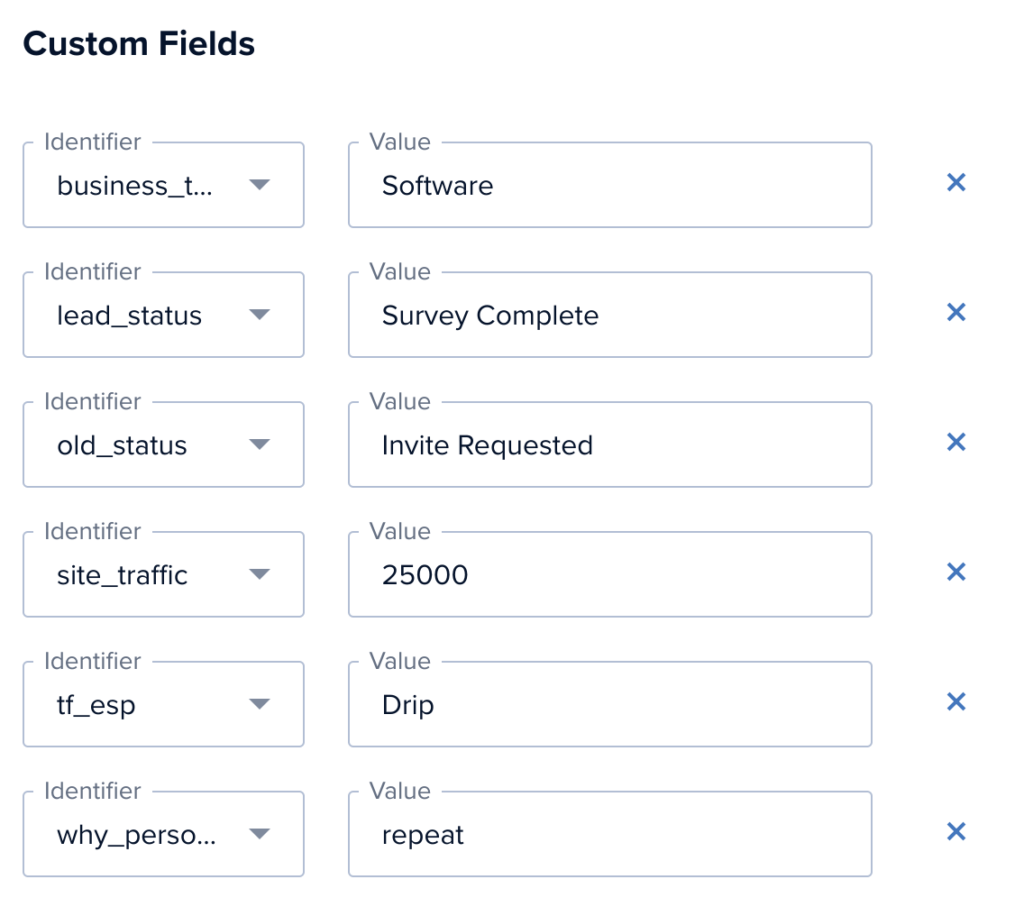
Here’s a subscriber who’s completed a few survey questions. We know they’re a software business that gets ~25,000 visitors a month to their site, they use Drip, and they’re interested in personalization because they want to capture more revenue from existing customers.
By mass emailing your list with a new survey, or sending out a survey a few days after someone joins your list or buys from you, you can start to not only learn more on a macro level about who makes up your audience — but you can also individually profile people.
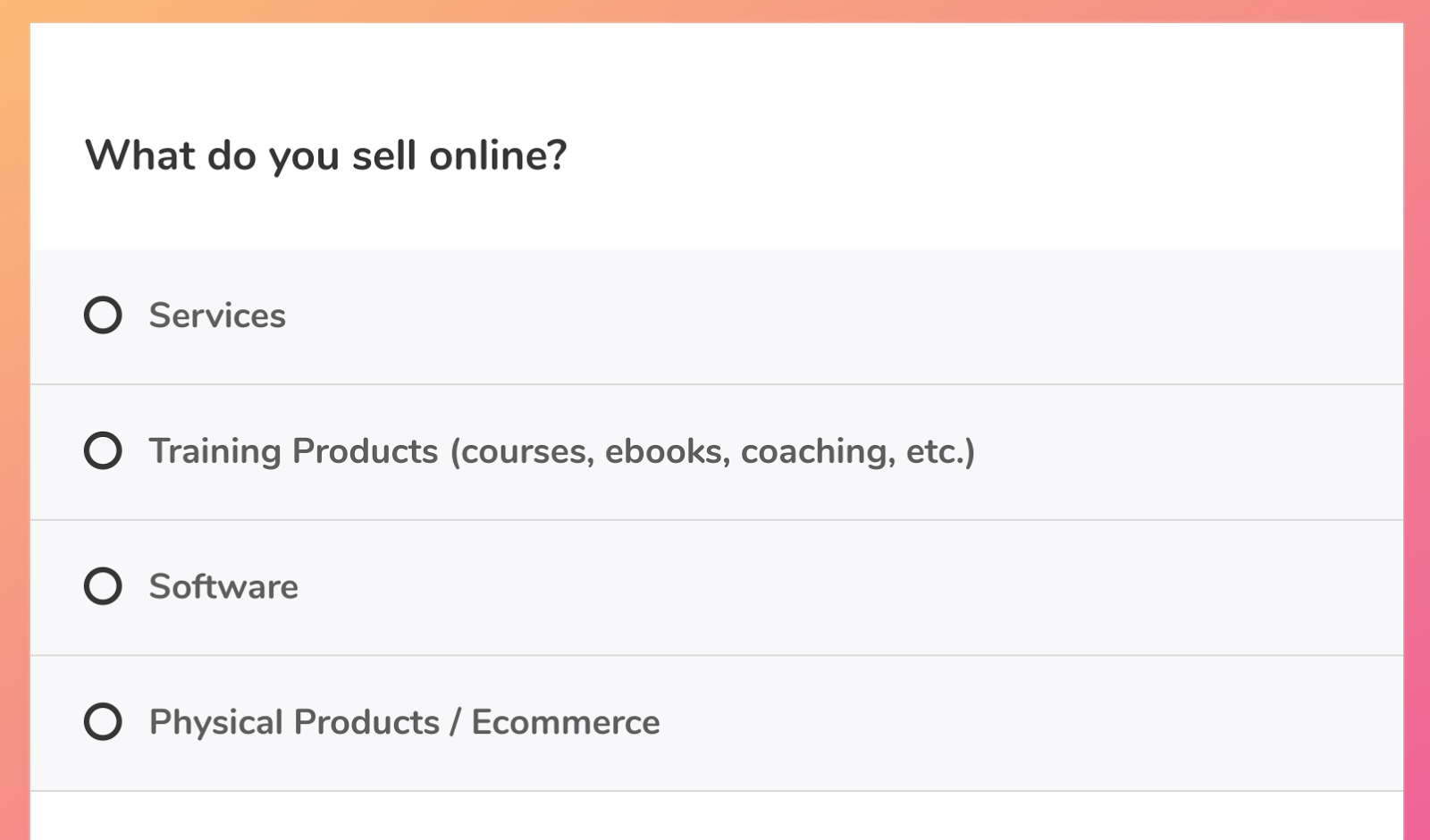
At RightMessage, the confirmation screen after joining our list is a Typeform survey that asks a bit about what someone wants with personalization and why that matters to their business. If they don’t complete the survey, we keep nudging them over email until they do.
About half of our subscribers end up completing this intake, which helps us better answer big-picture questions like, “What kind of businesses should we be targeting?”
But it also lets us totally transform the entire down funnel experience of these people — the emails we’re sending them, the way we describe our features, and even the case studies we send them. By making it so our subscribers need to put less effort towards answering the question of how our software will help, we’ve been able to turn more subscribers into customers.
Trigger link assessments
Trigger links are specially coded links that update someone’s profile automatically. I’m a big fan of using trigger links as a segmentation tool.
Rather than asking your subscribers to fill out a form, you can have them just click the most appropriate link that describes them. This is best done after you’ve collected a good amount of response data and have an idea of what the most common inputs are. Think of it like those “suggested responses” in Gmail.
Double Your Freelancing’s primary email course (which I wrote about in my last IWT article and referenced above) now has trigger link assessments at the end of each lesson. Instead of filling out a survey, I ask them to click a link.
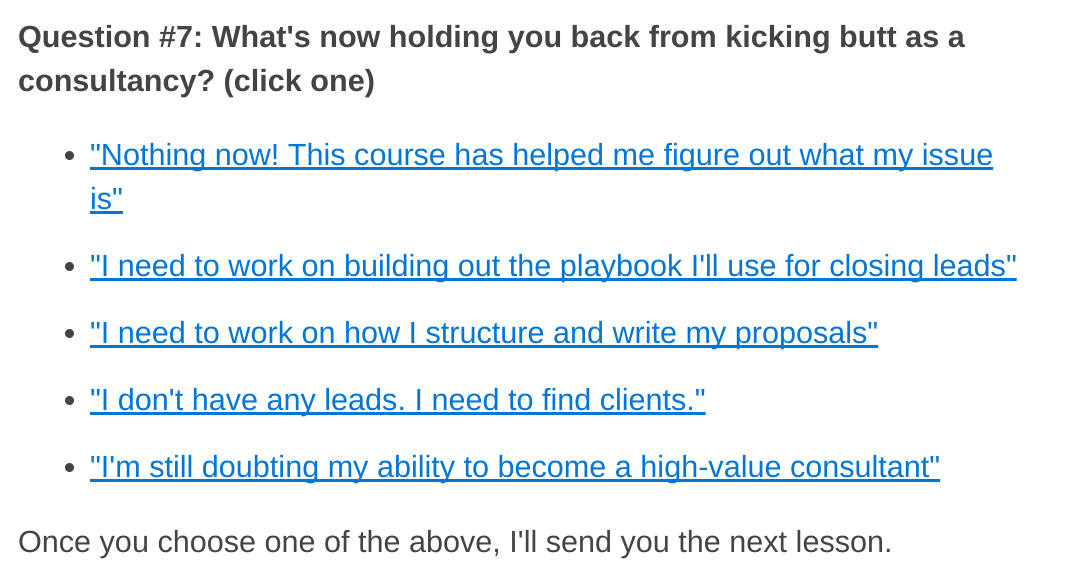
The course is nine emails long, and each lesson includes a quick trigger link survey at the bottom. Only about a third of people who join the course complete all the lessons.
Pages viewed
Some email marketing apps (like Drip) allow you to trigger actions when particular pages are viewed. This is done by embedding some code on your website that pings Drip (or your app of choice) when a user takes a certain action.
This is useful because you can tell a lot about what sort of content someone is reading. While it’s by no means a perfect science, segmenting based on what pages someone’s viewed (or hasn’t viewed) can allow you to approximate who someone might be or what someone might want.

By taking inventory on some of the key pages on your website that don’t have a call-to-action (like a lead magnet or a purchase), you can try to identify what an intentional view might say about who someone is.
Remember: This sort of segmentation is an approximation, not a guarantee. Someone buying a course on “How to hire your first employee” is much more likely to be a growth-minded small business as compared to someone who just viewed the course’s sales page.
If you want to track pageviews I suggest Drip, ActiveCampaign, ConvertKit (with their WordPress plugin), or HubSpot.
Facebook segmentation
Facebook knows a lot about you. You’ve probably told Facebook where you live, your gender, when you were born, what you like, and so on.
Advertisers on Facebook use this to their advantage: They’re able to create highly targeted ad campaigns that end up allowing them to put ads in front of people who probably belong to their target audience.
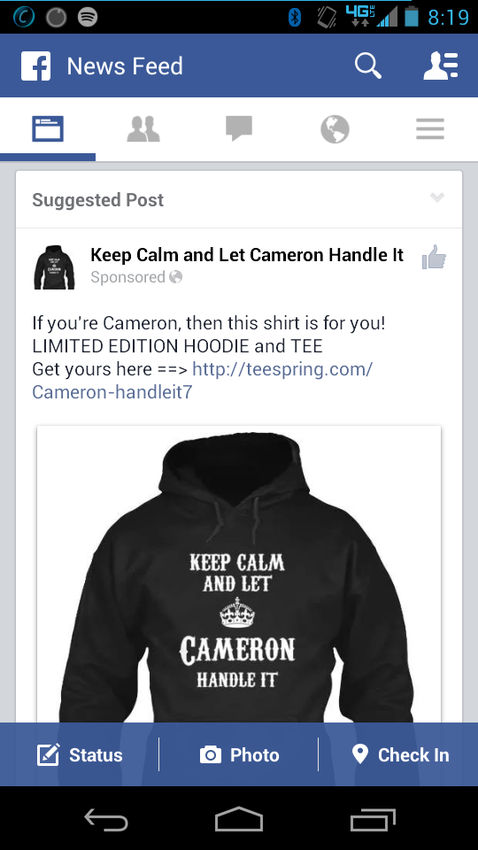
This ad targets anyone named Cameron. Weird, right?
Facebook isn’t just going to give you a bunch of data about an individual. However, by creating a super-specific ad campaign, you can pass information about the segments you’re targeting back to your website.
We’re doing this currently with a campaign we’re running for RightMessage.
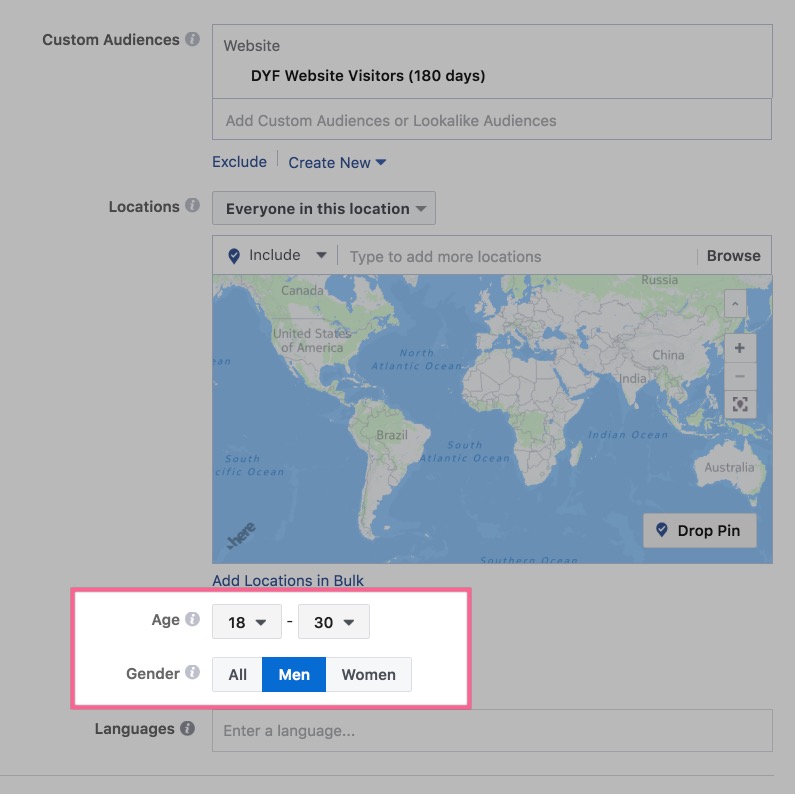

Like many businesses, we’re running what’s called “remarketing campaigns” to people who have already visited our website but didn’t opt in or otherwise convert. But instead of just running a single campaign that targets anyone who visited, we’ve segmented out that campaign:
- Men in North America who’ve visited our site
- Women in North America
- Men in the U.K.
- Women in the U.K.
- Men in Canada
- Women in Canada

Because we’re selling personalization software, this is more for effect. Here’s the personalized landing page we’re driving traffic to:
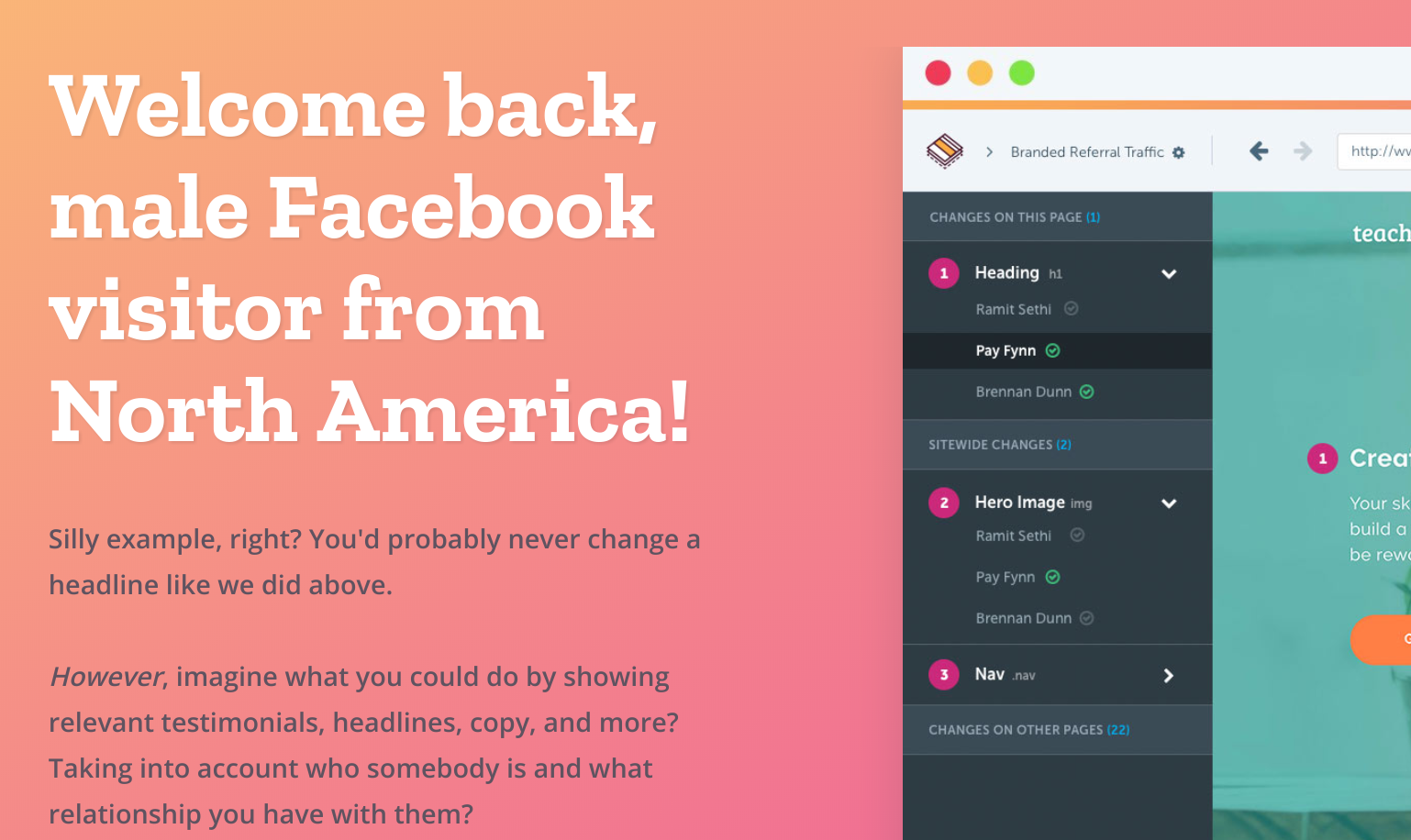
I’ve helped people run segmented ads targeting different demographics or interests, which would then translate to highly personalized sales pages with headlines, testimonials, and content that directly relates to the targeted audience. I’ll get to how to customize your site to react to the segment information. But for now, you should just know that this is totally possible with minimal coding.
If you’re targeting women between the ages of 18-30 with an ad, be sure to send that traffic to a landing page designed for those segment combinations (“female” and “aged 18-30”). The more relevant the landing page, the more likely someone is to take action on it.
But don’t just stop there.
If they convert, attach this information to their subscriber record in whatever email marketing app you use. Enrich their profile with the data that Facebook has given you, and combine it with behavioral or explicit data that you’ve collected on your end.
Manual data entry
Not the sexiest approach, but if you sell services or high-value products and do some form of in-person networking or sales, then you can take into account either where you met someone or who they know.
Chris Bintliff, a marketing consultant, feeds new business contacts of his into his email marketing app. And rather than just keying in their email address, he stores their first name, job title, industry, and more.
Considering that he’s charging at least five figures for a consulting engagement, customizing the experience of people he’s met in the flesh to speak directly to their role, their industry, and their individual identity means that more leads end up thinking, “OK, this guy gets me.”
And that’s exactly what we’re trying to do here: Show people we understand as a result of categorizing them based on demographic or interest.
Here’s an example of what a complete profile can look like. This is what my email database knows about someone who’s gone through my email course:
- She’s named Nicola
- Freelancer
- Web developer
- Hasn’t gone full-time yet
- $20k-$50k USD annual revenue
- Needs help with basic pricing (as opposed to value pricing)
- Has turned to online calculators in the past to help determine hourly rate
- What’s holding her back from implementing what I taught in the free course? Lack of project leads.
Each one of these is a tag or segment in my database. Here’s a snapshot of how Nicola is represented: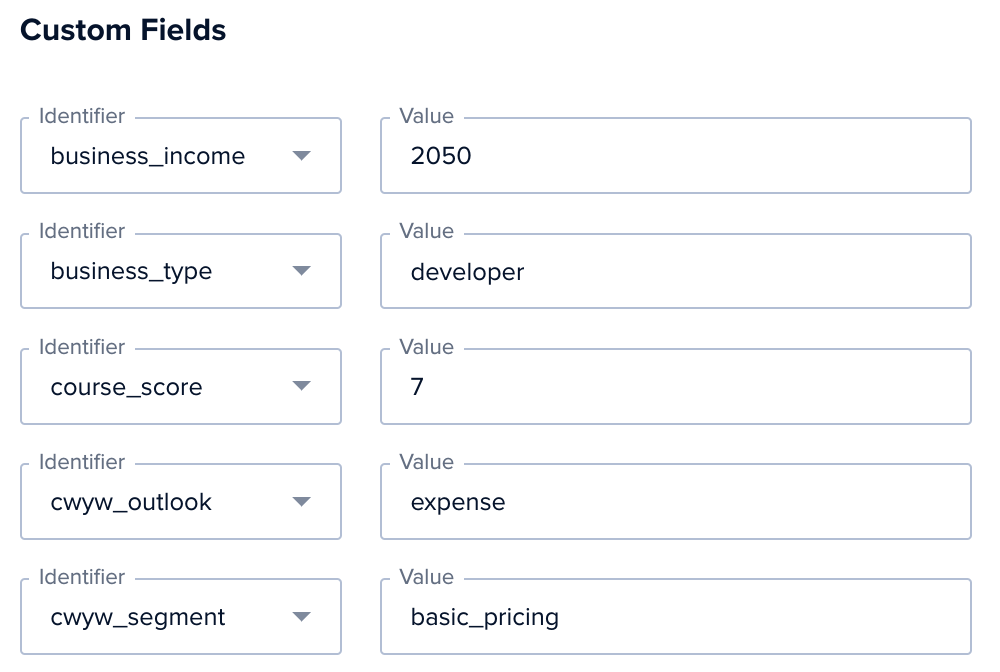
(This is just where you can get started. What else is possible? A lot. Behavioral segmentation based on content consumption habits. Segmenting by the type of website that sent you a visitor, or the original landing page they landed on organically. Email engagement. And so on.)
Learn to take control of your finances and spend your money GUILT-FREE with our free Ultimate Guide To Personal Finance below:
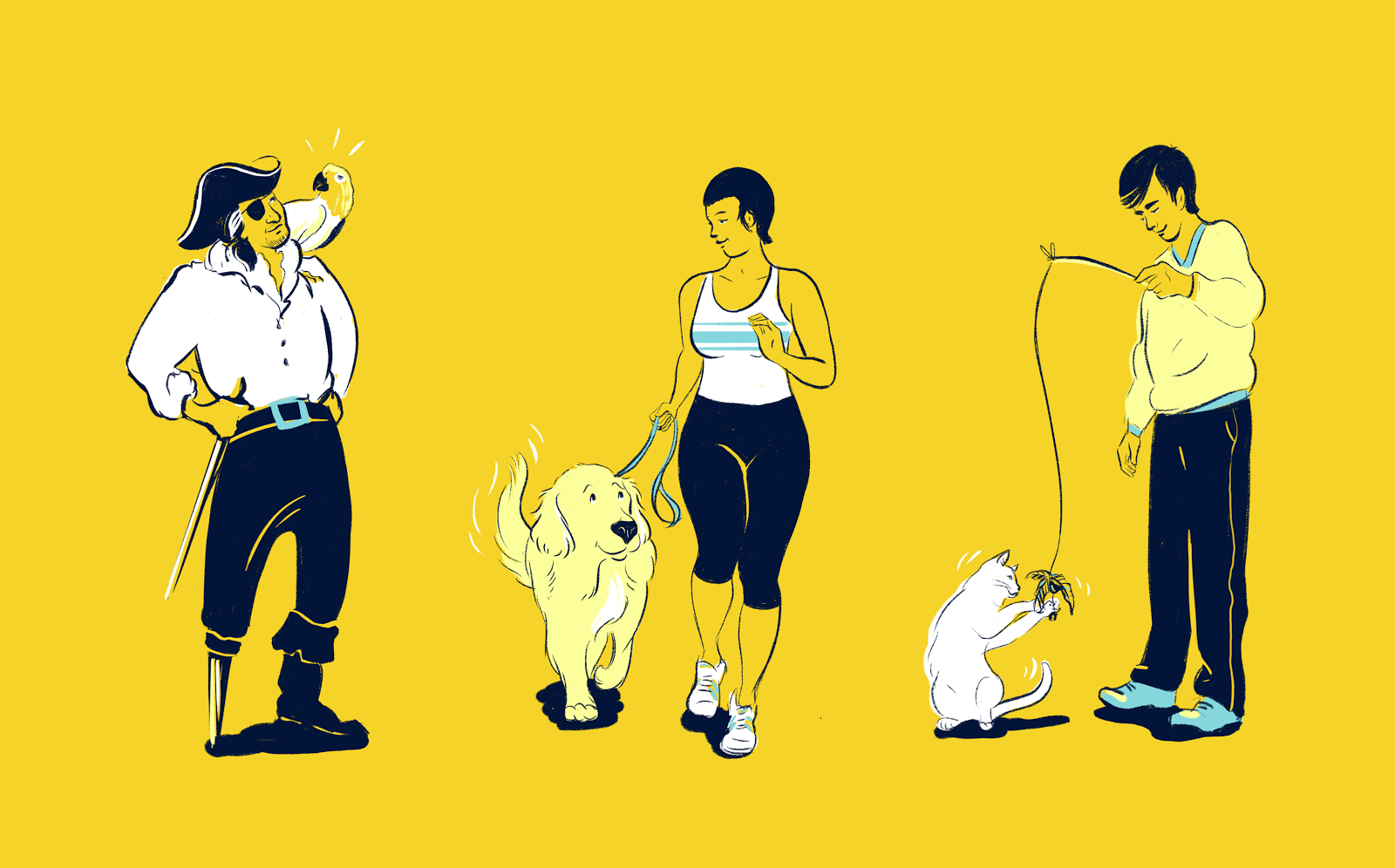
There are three reasons to segment:
- To develop a more accurate, top-level overview of who your audience is and what they need from you.
- To associate reports (subscriber/customer valuation, conversion funnels) with segment data so that you can identify your most (and least) valuable and performant segments.
- To personalize the experience that individuals have when engaging with you.
This final section is all about reason number three: to personalize the experience.
But how do you personalize?
For the purposes of this article we’re going to focus on customizing two media: email and web pages.
Like we discussed earlier, I’m going to assume a few things:
- You’re storing subscriber segment data in your email marketing software (like Drip or MailChimp).
- Your software allows adding tags or custom fields to your contacts.
- Even though you might have multiple databases, like your e-commerce platform or CRM, for the purposes of personalization we’re going to treat your email marketing database as your “single source of truth” that you’re using to track subscribers and the segments they belong to.
Remember Nicola from above?

With this context, built progressively and over the span of nine email lessons, I’m able to make slight changes to copy thanks to my email marketing app’s support for inserting variables.
Personalizing your email content
If you’re using automation, you can place people down different paths depending on the segments they belong to.
However, this can quickly get complicated. If you’ve ever seen “The Price is Right,” you’re probably familiar with the Plinko game. A puck is inserted at the top of the game, and plinks randomly down a series of pegs. I’m no mathematician, but there are probably hundreds, if not thousands, of ways for the puck to get from the top of the game to the bottom.

But it doesn’t need to be that complicated. You can start with just a single path. Do they choose Segment A? Then they go down the A path. B? Then the B path.
As you start to see results, you can then add more complexity.
Alternatively, a few email marketing apps allow you to add conditional content within a single email. This means you can say something like: “If they belong to Segment A, show this paragraph of text. If B, show that paragraph. Something else? Show this other paragraph.”
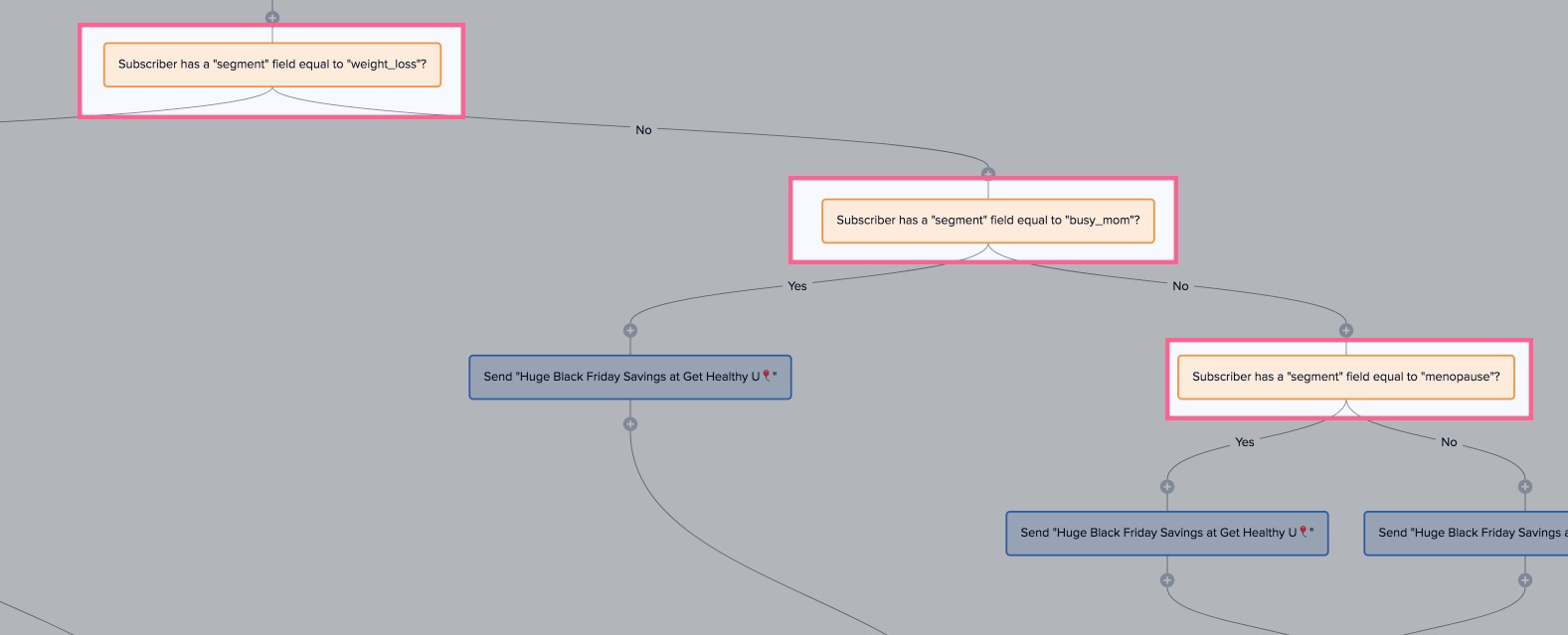
Personalizing your sales pages
This gets a little more complicated.
Chances are, you’re storing subscriber data in your email marketing app. So it becomes pretty trivial to have automations that look at whether the current subscriber has a certain tag or custom field and make an emailing decision based on that. And since a few of the leading email marketing apps now support conditional content within emails, it’s even easier.
To personalize your website to speak directly to your subscribers, you need to:
- Get subscriber data from your email marketing app synced with your website.
- Find a way to associate site visitors with subscribers.
- Be able to modify your site content based on subscriber data from your email marketing software.
This either requires a lot of programming effort or using software like, ahem, RightMessage. (The former is what led me to build a company based on personalization. No one wants to hear “write a lot of code” as a solution to a problem.)
But I want to keep this article simple. I don’t want you to need to write code or buy anything new. So here’s an easy way to achieve many of the benefits of personalization without a lot of effort.
Ready for it … ?
Make a few copies of your sales page and make a few changes.
That’s it.
Choose a segment, like business type or industry, and make copies of your sales page.
Make the following changes:
- Have the headline speak directly to people in that industry.
- Swap out generic examples and language and reuse the glossary of content you acquired back when you were collecting data.
- Use only testimonials and case studies from others in this industry.
- Replace any trust symbols or logos with organizations this industry recognizes and trusts.
- Reframe your offer to fit the exact needs of people in this industry.
If you were at an industry event, you’d describe your product or service exactly as I described above. You’d take into account the industry, and reframe the way you pitch your product. The same rules apply just as equally online.
Then, when you’re pitching someone over email, link people in Segment A to Sales Page A, Segment B to Sales Page B, etc.
(This doesn’t scale very nicely, especially if you end up with dozens of potential pairings, but it’s a good start.)

Overwhelmed? Don’t be.
Kathy Sierra, the aforementioned author of Badass: Making Users Awesome, wrote an article back in 2005 that was instrumental in helping lead me down this path of personalization.
She was working on a consulting project for a major automobile manufacturer. Her team was working on a “Choose a car” kiosk application, allowing people at a dealership to answer a series of questions that would yield the best car option for them.
The first question they asked was what someone most wanted in a car. Was it reliability? Safety? Resale value?
Depending on the answer to that first question, every subsequent question would slightly change. If “safety” was chosen, language like “engineered with your safety in mind” and pictures of kids in car seats would show up throughout the rest of the survey. And the phrasing of every future question would slightly change based on that pivotal first answer.
She writes, “And according to the client, it was a huge success! People spent much more time on each screen than in the previously uncustomized version.”
People wanted to use the kiosk, because it was reacting to how they were answering — rather than just leading someone through a series of stock questions.
From Kathy, “When it comes to your features and even benefits, one-size-does-not-fit-all. Try to find ways to connect what you do/have to what each individual finds personally meaningful. The good news is that it can take only the tiniest, subtlest shift in how you frame the information to help someone make that connection.”
It doesn’t take much to successfully personalize. It’s not a choice of either a completely personalized, end-to-end experience or nothing.
Let’s say you’re gearing up for a big new launch …
What if you could spend less than an hour and increase your sales by 5-10%?
And what if it didn’t require any new tools or new software to make that happen?
Would it be worth it? Would you do it?
I mentioned above that one of my sales pages is converting 70% higher against the unpersonalized control.
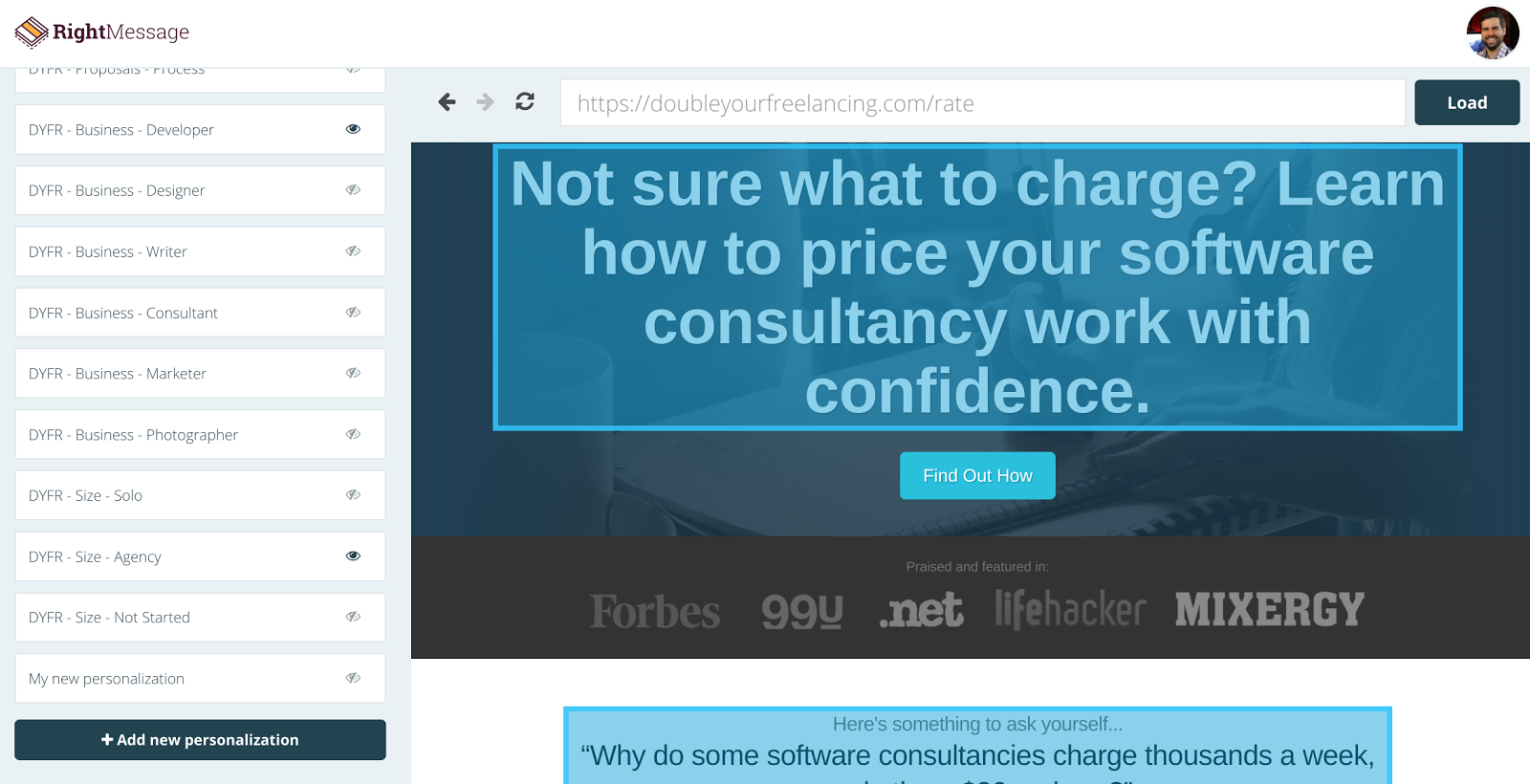
I’m using RightMessage to create a total of 81 possible variations of the above sales page. This might seem overwhelming. But it’s really just a small series of changes — a bit like a Mad Lib (remember those?).
If someone is a developer, the headline and the supporting copy describes them as a “freelance developer.” Are they also an agency? Then I call them a “software consultancy.”
I collect data via worksheets attached to the free email course that leads up to the sales page, and then I leverage that data to make slight changes to the content and copy of the page. It makes sense why a more relevant, more specific sales page converts better than something more generic, right?
But here’s what I want to leave you with, and I’m hoping you’ll think through what this means for your business: I believe that more personalization, while being more profitable for us (as business owners), also leads to a better user experience.
When I’m put in front of a product or service, I want to think less about how this will benefit me. If I need to try to figure out how you can help me, then there’s a good chance you’re going to lose me.
That’s why I think personalization is so critical. It’s not a “growth hack.” It’s a strategy that, when ethically leveraged, will make what you’re saying more relevant to your audience.
Better for you and better for your visitors, subscribers, and customers — present and future.
Wish you could connect with more amazing people, and not feel awkward in social situations? Download our FREE Ultimate Guide to Social Skills below.